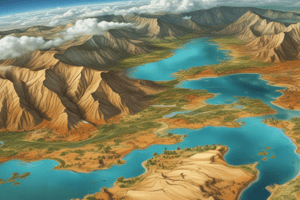Podcast
Questions and Answers
What is the primary goal of remote sensing?
What is the primary goal of remote sensing?
- To study daily weather and long-term climate change
- To model ecosystems of vegetation, water, and snow/ice
- To monitor urban-suburban land-use and land cover
- To obtain information about an object, area, or phenomenon without physical contact (correct)
What is the purpose of calibrating remotely sensed data?
What is the purpose of calibrating remotely sensed data?
- To make it more aesthetically pleasing
- To enable comparison of data obtained on different dates (correct)
- To reduce the amount of data collected
- To make it more accessible to the general public
What is an example of a biophysical characteristic that remote sensing data may be calibrated with?
What is an example of a biophysical characteristic that remote sensing data may be calibrated with?
- Population density
- Weather patterns
- Leaf-area-index (correct)
- Land use/cover
What is the name of the device used to measure spectral reflectance?
What is the name of the device used to measure spectral reflectance?
What is the purpose of in situ measurement in remote sensing?
What is the purpose of in situ measurement in remote sensing?
What is the primary reason fieldwork is necessary in remote sensing?
What is the primary reason fieldwork is necessary in remote sensing?
What is the term used to describe the data collected in the field?
What is the term used to describe the data collected in the field?
What is a common problem associated with in situ data collection?
What is a common problem associated with in situ data collection?
What is the definition of remote sensing?
What is the definition of remote sensing?
Where is the sensor typically located in a remote sensing system?
Where is the sensor typically located in a remote sensing system?
Flashcards are hidden until you start studying
Study Notes
Definition of Remote Sensing
- Remote sensing is the science and art of obtaining information about an object, area, or phenomenon through the analysis of data acquired by a device that is not in contact with the object, area, or phenomenon under investigation.
Applications of Remote Sensing
- Remote sensing technology is used to obtain accurate, timely information for a variety of applications, including:
- Study of daily weather and long-term climate change
- Urban-suburban land-use/land cover monitoring
- Ecosystem modeling of vegetation, water, snow/ice
- Food security
- Military reconnaissance
- Many others
Importance of In-Situ Measurements
- In-situ measurements are necessary to support remote sensing data collection
- In-situ measurements are used to calibrate remotely sensed data in two ways:
- Geometrically (x, y, z) and radiometrically (e.g., to percent reflectance)
- Comparing remotely sensed data with ground truth data
Limitations of In-Situ Data
- In-situ data may contain errors due to:
- Biased sampling design
- Improper operation of in-situ measurement instruments
- Uncalibrated in-situ measurement instruments
Remote Sensing Data Collection
- Remote sensing instruments collect information about an object or phenomenon within the instantaneous-field-of-view (IFOV) of the sensor system
- The sensor is located on a suborbital or satellite platform
Definitions of Remote Sensing and Photogrammetry
- Remote sensing is the measurement or acquisition of information of some property of an object or phenomenon, by a recording device that is not in physical or intimate contact with the object or phenomenon under study
- The American Society of Photogrammetry and Remote Sensing (ASPRS) defines photogrammetry and remote sensing as the art, science, and technology of obtaining reliable information about physical objects and the environment, through the process of recording, measuring, and interpreting imagery and digital representations of energy patterns derived from non-contact sensor systems
Studying That Suits You
Use AI to generate personalized quizzes and flashcards to suit your learning preferences.



